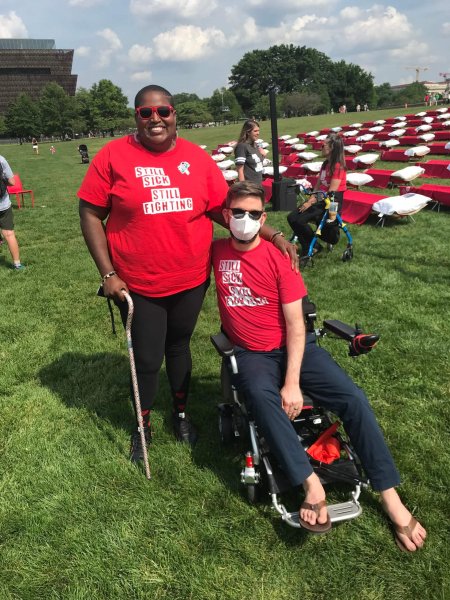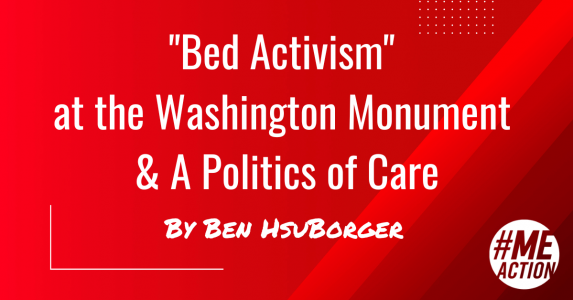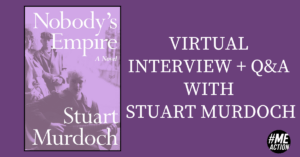I’ve been involved in planning many #MillionsMissing actions during my time with #MEAction, but for me, protesting at the Washington Monument this past May 12th was a different—even surreal—experience.
The installation of cots was so large that I could see people coming across the mall to see what it was. I would tell them that the beds symbolized the millions missing due to ME and Long COVID, but my favorite part was explaining the personally decorated pillowcases with custom messages that sick and disabled people across the country had sent in. I would see a mix of confusion, surprise and curiosity flash across their faces as it dawned on them that these people were missing, but not gone, (though some have lost their lives) and were sending messages to them through their pillowcases.
I felt I was beholding a kind of portal magic or space travel as we beamed the stories of those missing and marginalized by government neglect onto a monument memorializing the supposed greatness of our nation. It was incredibly moving to see the “bed activism” of ordinary people represented in this center of power. I remember a couple coming up to me late in the afternoon telling me they wanted to get a picture of a specific pillowcase that their sick friend in Alabama had sent in to be part of the demonstration and how proud and grateful I felt to bear witness to these moments of connection and to be exploring together new forms of creative, disabled resistance and world-making.

But if I’m honest, that day was also complicated for me as my role as an activist and US Director for Advocacy crashed into the hard reality of my disabled mind and body. In the weeks leading up to the event I had miscalculated my cognitive limits and overexerted myself resulting in an onset of post-exertional malaise and neurological symptoms I hadn’t experienced before. Though my worsening symptoms were invisible to most, it got so bad I couldn’t read any of the prepared remarks by eight amazing speakers who had come to DC to speak at the protest. Instead I spent the day shuffling between mostly minor tasks on the periphery of the event that weren’t cognitively demanding.
I felt more like an observer than an activist, but I tried to make peace with my body-mind limits instead of fighting them and it allowed me to pay more close attention to the small webs of care that the MillionsMissing volunteers and activists around me were weaving. It turned out to be a brutally hot day in D.C. to be out on the national mall. At first I was alarmed for the health of any people with ME or Long COVID who might be unprepared to be out in this weather. I kept nervously speeding from one cluster of people to the next in my power wheelchair checking on their status.
I knew our community was wise and resourceful from years of navigating complex chronic illness with too few supports, but I was still surprised to see so many people, who society often views as incapable or unproductive, spontaneously mobilize to help each other. My inquiries and offers of help were countered by activists who unzipped hidden pouches and transformed their wheelchairs into mobile care delivery units for others.

At one point during the speakers’ remarks I looked up to see a pwME volunteer alone on their walker-chair at the edge of the cot installation at the top of the hill. I grew immediately concerned they had been stranded in the heat and drove my power chair up to check on them only to find they were confident and prepared as a military general strategically positioning themselves on the field of battle and ready to deploy for ME advocacy opportunities with any oncoming tourists. When I asked how they were doing they opened a bottomless, Mary Poppins bag to offer me electrolytes.
The disabled writer Johanna Hedva says in their “Sick Woman Theory” essay that, “The most anti-capitalist protest is to care for another and to care for yourself. …To take seriously each other’s vulnerability and fragility and precarity… To protect each other, to enact and practice community… a politics of care.
That day on the Washington Monument I felt the truth of those words in a deeper way as I witnessed and participated in giving and receiving care to each other even as we protested the injustice of the government’s policy of neglect.
At the end of the event I looked over to see Jaime Seltzer, my long-time colleague, co-conspirator, and #MEAction Director of Scientific and Medical Outreach having difficulty standing or walking. She had just given an impassioned speech at MillionsMissing and I was grateful for the ways she had privately supported me when I was struggling with my new cognitive symptoms. This was the moment I knew I had been saving my own energy “spoons” for all day and I was grateful to be able to spend them on a friend. I pulled out my collapsible cane from under my seat and slipped out of my power wheelchair so Jaime could take my place. I walked alongside her across the lawn and back to the street where she could get transportation back to our hotel.
It was moments like these from MillionsMissing that most impacted me. When as a community we practiced our collective activism together, some on-site and others remotely across long distances. Where we intermingled our public advocacy with our private care. However each of us showed up that day, we knew that we were not alone. Yes, we are still sick, still fighting, but we would do it the only way we knew how–together.
In this fight,
Ben HsuBorger
U.S. Advocacy Director
PS: If you are able to give financially at this time to #MEAction, I would really appreciate it. It is experiences like this that highlight how much work there is to be done and how powerful this community can be when we come together.





